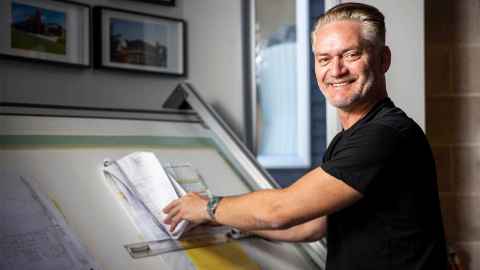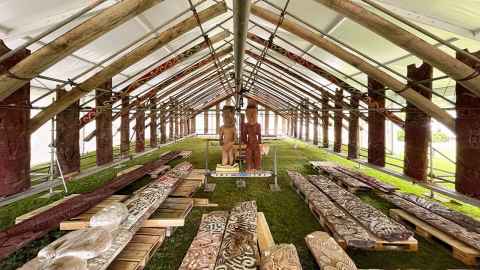Reviving an endangered Māori building technique
27 July 2022
Researchers at the University are reviving an ancient Māori building technique and testing it for seismic resilience.

Researchers at the University of Auckland are reviving a sophisticated Māori construction technique, mīmiro, to rebuild a historic Bay of Plenty wharenui, Tānewhirinaki, that hasn’t stood since the Napier earthquake.
The project led by Professor Anthony Hoete (Ngāti Awa, Ngāti Rānana), School of Architecture and Planning, has recently been awarded funding from Toka Tū Ake EQC (Earthquake Commission) to build a full-scale prototype timber structure using mīmiro and to test its seismic resilience.
The team includes Dr Jeremy Treadwell, who researched mīmiro building techniques for his PhD thesis at the University which involved the digital reconstruction of Tānewhirinaki, and Professor Jason Ingham, head of Civil and Environmental Engineering.
Mīmiro is a form of post-tensioning which gave wharenui and other buildings remarkable structural stability. The technique and its components were largely located between the interior and exterior surfaces of the whare and hidden from view.
“The origins of mīmiro can be traced back to the ships and strong sail lashing our ancestors used to travel across the Pacific,” says Dr Hoete. “They had a deep knowledge of building and creating strength and tension in structures, so we want to recreate those techniques that have been lost and use them to give our wharenui greater seismic resilience.”
Dr Hoete believes there is only one known whare remaining in Aotearoa New Zealand built with mīmiro techniques, which is Whakāta in the Okains Bay Museum on the Banks Peninsula.
Knowledge of mīrmiro was likely passed on and refined through word of mouth, from rohe to rohe, knowledge that is now endangered, says Dr Hoete.
“It’s a matter of urgency that we better understand and document and treasure a practice that exemplifies Māori building knowledge.”
The team is working closely with Ngāti lra o Waioweka who built the original Tānewhirinaki wharenui near Opōtiki during the 1860 New Zealand Wars, only to witness its destruction in the 7.8 magnitude Napier earthquake in 1931.
The most important carvings representing the iwi’s ancestors were saved from the wreckage and remarkably stored in a shed at the marae for nine decades.

In January 2022 a wānanga was held at Waioweka Marae, where the carvings were brought out from the shed and suspended from scaffolding.
“For all but two members of the hapū it was the first time they had seen the carvings of their ancestors standing, albeit temporarily, so it was pretty special,” says Dr Hoete.
His team lashed the carvings to a scaffolded framework, before LiDAR scanning the framework with lasers to create an accurate record of the physical dimensions of each carving. This information could then inform the reconstruction of Tānewhirinaki.
The original timber carvings had deteriorated over the past 90 years and not able to carry the loads of a reconstructed wharenui.
“So instead, we will design a new structure that will act like an outer whare to which we will sensitively attach the original carvings to the inside of this new structure.”
The team is currently designing the timber structure, using interlocking compression joints instead of bolting parts together, while tensile elements will pull the structure to the ground, like a tent.
“I would describe it as structural sculpture,” says Dr Hoete. His ancestors would have used flax to create the lashings but for practical reasons they may have to opt for modern metal wiring.
Once the core structure has been completed, the team will pull the vertical portals sideways using a winch off a jeep to test the horizontal strength required for seismic resilience. Vertical strength will be tested by water weights.
“We are pretty confident in our designs, but the proof of concept will be in the real-life testing.”
It’s a matter of urgency that we better understand and document and treasure a practice that exemplifies Māori building knowledge.
Applying mīmiro to reconstruct Tanewhirinaki will inform understanding of a technique that could inform the construction of future wharenui, says Dr Hoete.
“Toka Tū Ake EQC wants to create more resilient communities through design and construction of stronger buildings, so Professor Hoete’s work aligns well with our goal to improve Aotearoa New Zealand’s resilience to natural hazards,” says Toka Tū Ake manager research Dr Natalie Balfour.
“Investing in Māori researchers and matauranga Maōri has been a key focus of this year’s biennial grants, so we are proud to be able to support this amazing project,” says Dr Balfour.
As well as Toka Tū Ake funding, the research is also supported by QuakeCoRE, the Centre of Research Excellence for seismic resilience and the Endangered Wooden Architecture Programme at Oxford Brookes University.
Dr Hoete is passionate about the wharenui project as well as getting the local community involved.
“We do a lot of outreach work with the local Māori community and schools, and some of the local youngsters have already shown an interest in a career in architecture, which is pretty amazing.”
“This project is about research and design, but it is also so much more. I believe this project has the power to transform our communities.”
Media contact
Margo White I Media adviser
Mob 021 926 408
Email margo.white@auckland.ac.nz